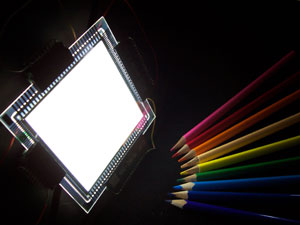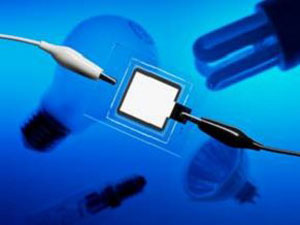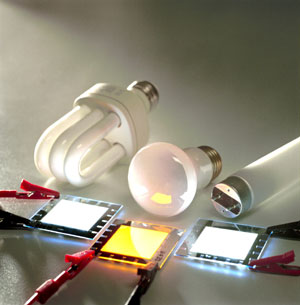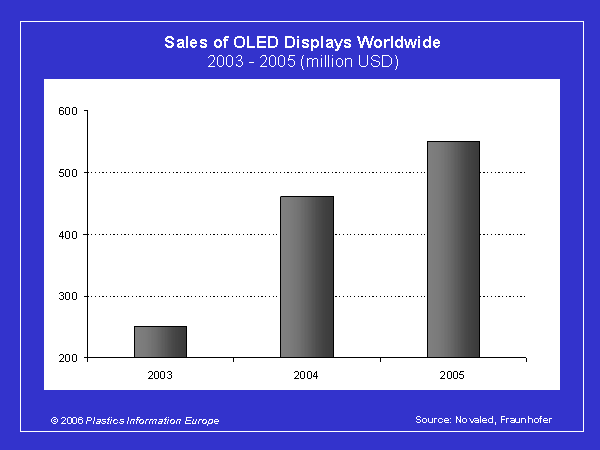ORGANIC LIGHT-EMITTING DEVICE
Significant advantages with large-area applications / OLED displays boom / European project for economical light production / In search of long-lasting blue polymers
OLEDs – Organic Light Emitting Device – are electronic components made of ultra-thin organic layers that emit light when a voltage is applied. Not only are they very flat, they can also be manufactured in large formats and are energy-effective in light production, according to the German Federal Ministry for Education and Research (BMBF; www.bmbf.de). The first samples showed that they are also flexible. In contrast to "classic" light emitting diodes (LEDs), OLEDs emit a diffused light – a significant advantage for applications in which large areas have to be illuminated or backlit. Their high level of brightness with strong contrast, their independence of the angle of view and their video capability are also advantages, as are their low weight and their compact, extremely thin shape.
"The first results from projects involving light-emitting diodes support the vision of an illuminated plastic film with entirely new application possibilities for lighting units and electronic displays. The focus of the work being carried out on the OLED technology is thus primarily in the display segment and general lighting," says the BMBF.
Display applications with high growth rates
In the display sector, considerable advances have been made since 1987 when two Kodak researchers, Ching Tang and Steve Van Slyke, managed to significantly enhance organic electroluminescence efficiency, allowing electrical energy to be converted directly into light. In 1999, Japanese consumer electronics giant Pioneer became the first company to use OLED displays in car radios. In the meantime, Samsung and RitDisplay have also come onto the market as major manufacturers of OLED displays. Other companies offering this technology include Universal Display Corporation (UDC), Idemitsu and Kodak (all US), CDT (UK), and Novaled and Merck (both Germany).
"The first results from projects involving light-emitting diodes support the vision of an illuminated plastic film with entirely new application possibilities for lighting units and electronic displays. The focus of the work being carried out on the OLED technology is thus primarily in the display segment and general lighting," says the BMBF.
Display applications with high growth rates
In the display sector, considerable advances have been made since 1987 when two Kodak researchers, Ching Tang and Steve Van Slyke, managed to significantly enhance organic electroluminescence efficiency, allowing electrical energy to be converted directly into light. In 1999, Japanese consumer electronics giant Pioneer became the first company to use OLED displays in car radios. In the meantime, Samsung and RitDisplay have also come onto the market as major manufacturers of OLED displays. Other companies offering this technology include Universal Display Corporation (UDC), Idemitsu and Kodak (all US), CDT (UK), and Novaled and Merck (both Germany).
 White OLED light source 7x7 cm2 (Photo: Novaled) |
Between 2003 and 2005, worldwide sales of OLED displays more than doubled from USD 250m to USD 550m, as is revealed by figures from Novaled (Dresden / Germany; www.novaled.com), a spin-off of the Institute for Applied Photophysics at the Technical University of Dresden (IAPP; www.iapp.de) and the Fraunhofer Institute for Photonic Microsystems (IPMS, Dresden / Germany; www.ipms.fraunhofer.de). By 2010, researchers expect market volume to grow to USD 2.4 bn worldwide. At the top of the list, with over 50%, will be mobile phone applications, but PDAs (for example for electronic appointment diaries), camcorders and digital cameras are also gaining in importance. At present, OLEDs are replacing mainly LCD and LED technologies. As soon as bigger surface areas become feasible, organic light emitting diodes could also be competition for conventional TV technology.
The manufacturers of OLEDs nevertheless still have a few major problems to overcome before they can establish the products more firmly on the markets and tap new applications. Novaled´s main objective for the near future is to improve energy efficiency, increase life expectancy and reduce costs. Against the strong Asian competition, the company sees particular opportunties in heavily technology-driven applications and in organic materials.
The economic potential of the OLED technology is considerable – a point that is also emphasised by the German research ministry. Display technology and lighting, it says, are mass markets with considerable growth opportunities. As German companies are particularly active in lighting (market volume in 2003: USD 121 bn), this sector is seen as especially ripe for the launch of organic light-emitting diodes.
Lighting systems in need of modernisation
The manufacturers of OLEDs nevertheless still have a few major problems to overcome before they can establish the products more firmly on the markets and tap new applications. Novaled´s main objective for the near future is to improve energy efficiency, increase life expectancy and reduce costs. Against the strong Asian competition, the company sees particular opportunties in heavily technology-driven applications and in organic materials.
The economic potential of the OLED technology is considerable – a point that is also emphasised by the German research ministry. Display technology and lighting, it says, are mass markets with considerable growth opportunities. As German companies are particularly active in lighting (market volume in 2003: USD 121 bn), this sector is seen as especially ripe for the launch of organic light-emitting diodes.
Lighting systems in need of modernisation
 The experts are undecided as to whether OLEDs will succeed in pushing the various conventional light sources from the market over the long term. (Photo: Novaled) |
Lighting currently accounts for around 8% of total energy consumption in Germany, so there is enormous potential in this segment there. The German Electrical and Electronic Manufacturers Association (ZVEI, Frankfurt; www.zvei.org), for example, reports considerable demand for modernisation of lighting systems. In German offices alone, it claims, more than 60% of all systems are inefficient. Through modernisation, up to EUR 200m could be saved every year, even without taking into to account the expected additional savings through OLED technology. Furthermore, says ZVEI, a third of all roads in Europe are still lit by technically outdated mercury vapour lamps. By replacing them with modern lamp technology, the operating costs would fall by up to EUR 700m a year.
In five years at the latest, notes BMBF, industry aims to put the first OLEDs onto the market as light sources, initially in decorative applications. One possibility would be to have coloured lighting elements that could, for example, be stuck to a wall or a refrigerator. It presumably will take somewhat longer before illuminated wallpaper that switches to a bright spring landscape on dull grey autumn days becomes reality – estimates suggest in around 15 years.
In five years at the latest, notes BMBF, industry aims to put the first OLEDs onto the market as light sources, initially in decorative applications. One possibility would be to have coloured lighting elements that could, for example, be stuck to a wall or a refrigerator. It presumably will take somewhat longer before illuminated wallpaper that switches to a bright spring landscape on dull grey autumn days becomes reality – estimates suggest in around 15 years.
 Four generations of light technology in one picture. (Photo: Philips) |
In the lighting segment, Europe is worldwide leader – in contrast to the display segment, where Asian countries are well in front. In order to maintain this lead, 24 companies, research institutes and universities from eight European countries have joined up in the "OLLA" project (Organic LEDs for ICT & next generation Lighting Applications; www.olla-project.org). Participants include global players such as Philips, Siemens and Osram. The project launched in October 2004 has a budget of around EUR 20m, including EUR 12m in EU funding, OLLA´s project manager, Peter Visser (Philips Lighting), told PIE. The aim is to jointly develop an OLED lamp by 2008 that uses very little energy and burns for at least 10,000 hours. By comparison, the average life expectancy of a normal incandescent bulb is around 1,000 hours, a low-energy lamp around 15,000 hours (depending on the type), and a fluorescent tube, sometimes over 20,000 hours.
However, the competition is not asleep. In Japan and the US, programmes are already in place to support industry and universities cooperating in this field, with the aim of creating national champions that are also leading global player, says OLLA.
Design and weight will initially be the chief criteria
The big problem is currently the production of the colour blue that is needed for white light with a sufficiently long life expectancy. "It is a bit like searching for the Holy Grail," says Visser; "the whole world is trying to find a solution." Other technical hurdles are, for example, the production costs, the light output, which is still to low, and the durability of the encapsulation.
Initially, says Fraunhofer IPMS, the products will probably be those for which design or low weight is more important than price – for example, signboards, billboards or the backlighting of LCD displays. However, as costs fall with increasing production, first designer lamps and later more affordable lamps will come into the shops for the everyday consumer. If the organic light emitting diodes can be applied to plastic film, products like roll-up lights for such occasions as beach parties should also become feasible.
But it is not only the lighting industry that is keenly following developments. In the automotive industry, for example, OLEDs could open up many new possibilities – well beyond an illuminated film under the car roof. Shaping a car body to accommodate the headlamps, for example, is still very time-consuming. A flat film would save a great deal of time and money and open up additional design variants.
Brief reports from the world of OLEDs
Japanese office equipment manufacturer Epson (www.epson.com) reports results equal to or even superior to those of conventional laser printers for the world´s first printing head to use the OLED technology as the light source. The prototype, developed together with Sumitomo Chemical (Europe: Machelen / Belgium; www.sumitomo-chemical.be), is noted above all for having a very tiny light source. Through the high illuminating power, shorter exposure times are possible enable faster printing speed. At the same time, Epson claims that the compact design allows a higher resolution, which is of major importance for the development of colour printers in particular. However, it is not yet known when the new OLED print heads will be released for series production.
After 13 years of research work, US researchers Mark Thompson and Stephen Forrest have made a breakthrough in light production with single-colour displays, according to a report in "Nature" magazine. The newly developed process makes it possible to obtain 100% efficiency from a single full-spectrum light source, says Thompson. Should it become possible to manufacture this unit economically in large quantities, interior lighting systems could look completely different in future. According to the report, the researchers have found a way to make the blue component more durable. The next hurdle is how to hermetically seal the light sources to protect them from destructive moisture.
Scientists from the Fraunhofer Institute for Applied Polymer Research (IAP, Golm / Germany; www.pioneers-in-polymers.com) have succeeded in building transparent OLED displays. Their brightness, life expectancy and efficiency are so high that initial commercial applications are foreseeable. "This was made possible by a new kind of metal electrode to supply the polymer layer with electric current," says the institute.
Because of their transparency, the displays can be combined with the traditional and now very highly developed TFT liquid crystal displays found in all kinds of devices. Fraunhofer´s research team is considering integrating additional functions or warnings directly into the OLED display as a luminous area or with flashing symbols. By combining the two types of display, the information density on the same area can be increased. Cooperation partner Optrex Europe (Babenhausen / Germany; www.optrex.de) has already produced samples such as hybrid displays.
However, the competition is not asleep. In Japan and the US, programmes are already in place to support industry and universities cooperating in this field, with the aim of creating national champions that are also leading global player, says OLLA.
Design and weight will initially be the chief criteria
The big problem is currently the production of the colour blue that is needed for white light with a sufficiently long life expectancy. "It is a bit like searching for the Holy Grail," says Visser; "the whole world is trying to find a solution." Other technical hurdles are, for example, the production costs, the light output, which is still to low, and the durability of the encapsulation.
Initially, says Fraunhofer IPMS, the products will probably be those for which design or low weight is more important than price – for example, signboards, billboards or the backlighting of LCD displays. However, as costs fall with increasing production, first designer lamps and later more affordable lamps will come into the shops for the everyday consumer. If the organic light emitting diodes can be applied to plastic film, products like roll-up lights for such occasions as beach parties should also become feasible.
But it is not only the lighting industry that is keenly following developments. In the automotive industry, for example, OLEDs could open up many new possibilities – well beyond an illuminated film under the car roof. Shaping a car body to accommodate the headlamps, for example, is still very time-consuming. A flat film would save a great deal of time and money and open up additional design variants.
Brief reports from the world of OLEDs
Japanese office equipment manufacturer Epson (www.epson.com) reports results equal to or even superior to those of conventional laser printers for the world´s first printing head to use the OLED technology as the light source. The prototype, developed together with Sumitomo Chemical (Europe: Machelen / Belgium; www.sumitomo-chemical.be), is noted above all for having a very tiny light source. Through the high illuminating power, shorter exposure times are possible enable faster printing speed. At the same time, Epson claims that the compact design allows a higher resolution, which is of major importance for the development of colour printers in particular. However, it is not yet known when the new OLED print heads will be released for series production.
After 13 years of research work, US researchers Mark Thompson and Stephen Forrest have made a breakthrough in light production with single-colour displays, according to a report in "Nature" magazine. The newly developed process makes it possible to obtain 100% efficiency from a single full-spectrum light source, says Thompson. Should it become possible to manufacture this unit economically in large quantities, interior lighting systems could look completely different in future. According to the report, the researchers have found a way to make the blue component more durable. The next hurdle is how to hermetically seal the light sources to protect them from destructive moisture.
Scientists from the Fraunhofer Institute for Applied Polymer Research (IAP, Golm / Germany; www.pioneers-in-polymers.com) have succeeded in building transparent OLED displays. Their brightness, life expectancy and efficiency are so high that initial commercial applications are foreseeable. "This was made possible by a new kind of metal electrode to supply the polymer layer with electric current," says the institute.
Because of their transparency, the displays can be combined with the traditional and now very highly developed TFT liquid crystal displays found in all kinds of devices. Fraunhofer´s research team is considering integrating additional functions or warnings directly into the OLED display as a luminous area or with flashing symbols. By combining the two types of display, the information density on the same area can be increased. Cooperation partner Optrex Europe (Babenhausen / Germany; www.optrex.de) has already produced samples such as hybrid displays.
 | |
12.06.2006 Plasteurope.com [205220]
Published on 12.06.2006
